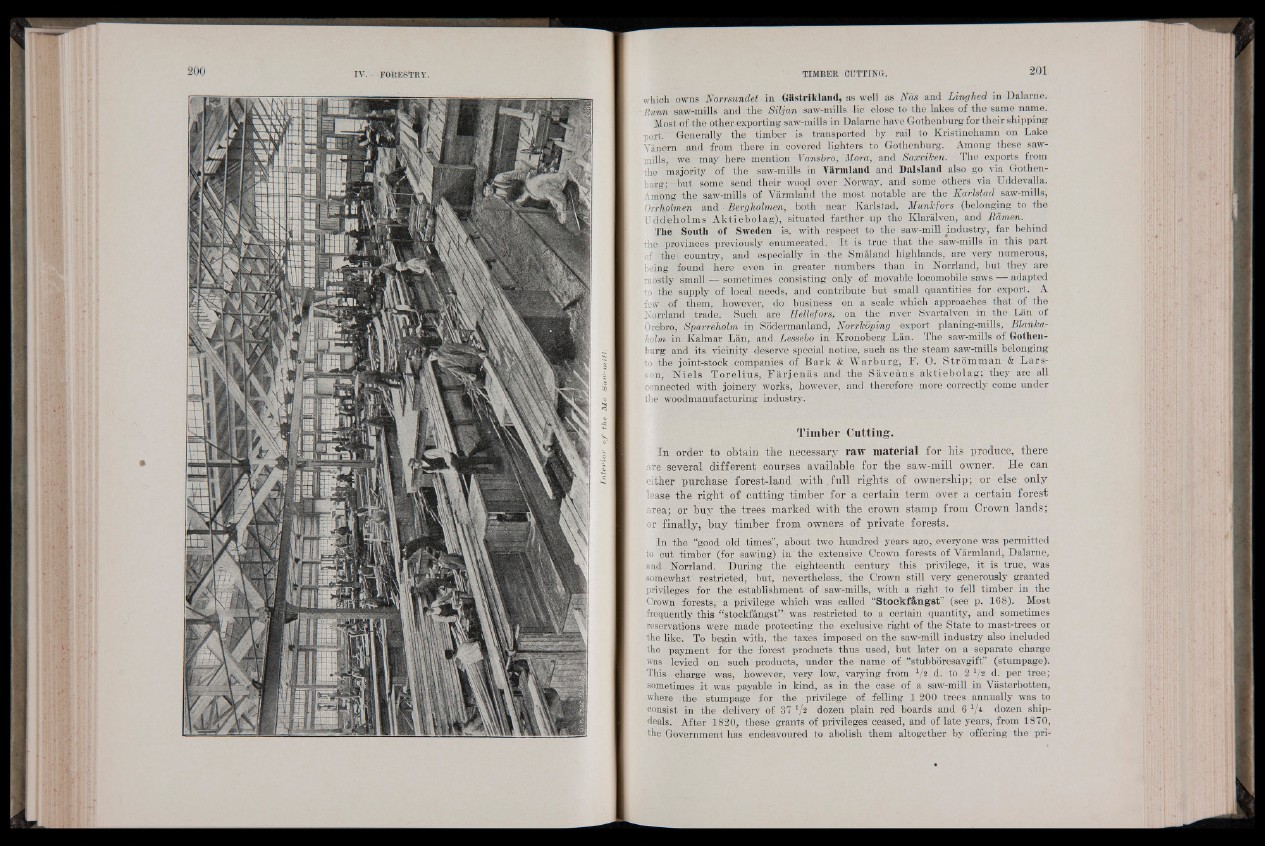
Interior of the Mo S aw -m ill.
which owns Norrsundet in GUstrikland, as well as Nas and Linghed in Dalarne.
Runn saw-mills and the Siljan saw-mills lie close to the lakes of the same name.
Most of the other exporting saw-mills in Dalarne have Gothenburg for their shipping
port. Generally the timber is transported by rail to Kristinehamn on Lake.
Vanem and from there in covered lighters to Gothenburg. Among these sawmills,
we may here mention Vansbro, 'Mora, and Saxviken. The exports from
the majority of the saw-mills in Yarinlaiid and Dalsland also go via Gothenburg;
but some send their wood over Norway, and some others via Uddevalla.
Among the saw-mills of Varmland the most notable are the Karlstad saw-mills,
Orrholmen and Bergholmen, both near Karlstad, Munkfors (belonging to the
U d d eh o lm s A k t ie b o la g ) , situated farther up the Klaralven, and Rdmen.
The South of Sweden is, with respect to the saw-mill industry, far behind
the provinces previously enumerated. It is true that the saw-mills in this part
of the- country, and especially in the Smaland highlands, are very numerous,
being found here even in greater numbers than in Norrland, but they are
mostly small — sometimes (consisting only of movable locomobile saws — adapted
to the supply of local needs, and contribute but small quantities for export, A
few? of them, however, do business on a scale which approaches that of the
Norrland trade. Such are Hellefors, on the river Svartalven in the Lan of
Örebro, Sparreholm. in Sodermanland, Norrkoping export planing-mills, Blanka-
liolm in Kalmar Lan, and Lessebo in Kronoberg Lan. The saw-mills of Gothenburg
and its vicinity deserve special notice, such as the steam saw-mills belonging
to the joint-stock companies of Bark & Warburg, F. O. S tr om m a n & Lars-
son, N i e ls T o r e liu s , F a r j e n a s and the S a v e a n s a k tie b o la g ; they are all
connected with joinery works, however, and therefore more correctly come under
the' woodmanufacturing industry.
Timber Cutting.
In order to obtain the necessary raw material for his produce, there
are several different courses available for the saw-mill owner. He can
either purchase forest-land w ith.fu ll rights of ownership; or else only
lease the right of cutting timber for a certain term over a certain forest
area; or buy the trees marked with the crown stamp from Crown lands;
or finally, buy timber from owners of private forests.
In the “good old times”, about two hundred years ago, everyone was permitted
to cut timber (for sawing) in the extensive Crown forests of Varmland, Dalarne,
and Norrland. During the eighteenth century this privilege, it is true, was
somewhat restricted, but, nevertheless, the Crown still very generously granted
privileges for the establishment of saw-mills, with a right to fell timber in the
Crown forests, a privilege which was called “Stockf&ngst” (see p. 168). Most
frequently this “stockfangst” was restricted to a certain quantity, and sometimes
reservations were made protecting the exclusive right of the State to mast-trees or
the like. To begin with, the taxes imposed on the saw-mill industry also included
the payment for the forest products thus used, but later on a separate charge
was levied on such products, under the name of “stubboresavgift” (stumpage).
This charge was, however, very low, varying from 1/2 d. to 2 1/2 d. per tree;
sometimes it was payable in kind, as in the case of a saw-mill in Vasterbotten,
where the stumpage for the privilege of felling 1 200 trees annually was to
consist in the delivery of 37 V2 dozen plain red boards and 6 V4 dozen ship-
deals. After 1820, these grants of privileges ceased, and of late years, from 1870,
the Government has endeavoured to abolish them altogether by offering the pri